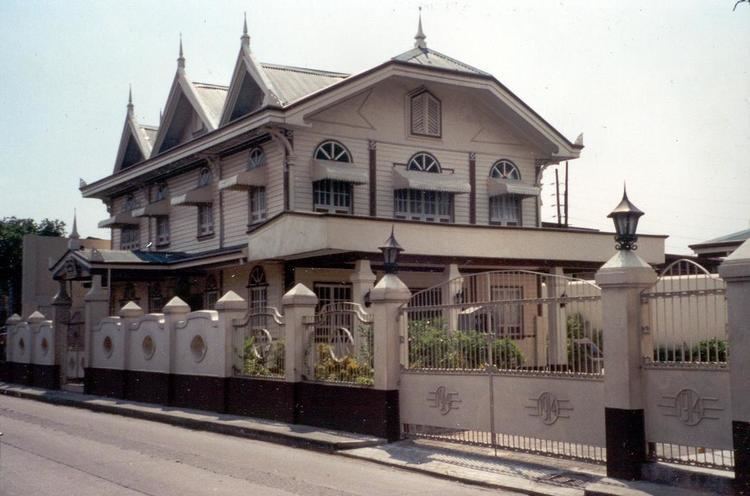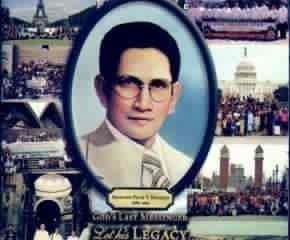Other names Ka Felix | Nationality Filipino Name Felix Manalo | |
 | ||
Born Felix Ysagun ManaloMay 10, 1886Barrio Calzada, Tipas, Taguig, Manila,Captaincy General of the Philippines/Spanish East Indies ( 1886-05-10 ) Died April 12, 1963(1963-04-12) (aged 76)Quezon CityPhilippines Children Gerardo (died at infancy)PilarAvelinaDominadorSalvadorEranoBienvenido | ||
Sarah Geronimo sings "Felix Manalo" theme song
Felix Ysagun Manalo (born Félix Ysagun y Manalo, May 10, 1886 – April 12, 1963), also known as Ka Félix, was the first Executive Minister of the Iglesia ni Cristo and incorporated it with the Philippine Government on July 27, 1914. He is the father of Eraño G. Manalo, who succeeded him as Executive Minister of the INC, and the grandfather of Eduardo V. Manalo, the current Executive Minister.
Contents
- Sarah Geronimo sings Felix Manalo theme song
- Pasilip sa pelikula ukol kay felix manalo
- Biography
- Founding of Iglesia ni Cristo
- Death
- Recognition
- In popular culture
- References

Because there were no precursors to the registered church, external sources and critics of the INC refer to him as its founder. The official doctrine of the Iglesia is that Felix Y. Manalo is the last messenger of God, sent to reestablish the church founded by Jesus Christ, which has fallen into apostasy following the end of the Apostolic Age.

Pasilip sa pelikula ukol kay felix manalo
Biography

Felix Y. Manalo was born in Barrio Calzada, Tipas, Taguig, Manila province (transferred to Rizal province in 1901 and now part of Metro Manila), Philippines, on May 10, 1886. He was raised in a rural setting by his devout Catholic parents, Mariano Ysagun and Bonifacia Manalo. With their livelihood based on a combination of agricultural work, shrimp catching and mat making, they were humble people who lived on the edge of poverty. During a childhood disrupted by his father's death, his mother's remarriage and the Philippine Revolution, and an adolescence overshadowed by the Filipino-American War, Manalo received only a few years of formal schooling.

Late in the 1890s, after a telling lapse of faith, the teenage Manalo rejected Catholicism. At the time he resided in Manila with his uncle Father Mariano Borja, a priest assigned to the urban parish of Sampaloc. Severely rebuked for privately studying the Bible, Manalo began forthwith to question many basic Catholic doctrines. He also sought solace in other religious groups. According to the National Historical Commission of the Philippines, the establishment of the Philippine Independent Church or the Aglipayan Church was his major turning point, but Manalo remained uninterested since its doctrines were mainly Catholic. In 1904, he joined the Methodist Episcopal Church, entered the Methodist seminary, and became a pastor for a while. He also sought through various denominations, including the Presbyterian Church, Christian Mission, and finally Seventh-day Adventist Church in 1911. There Manalo laboured as trusted evangelist before quarrelling with Adventist leaders over matters of doctrine and customary authority relationships between Westerners and Filipinos. He was left in 1913. Plainly displeased with the various branches of Christianity brought to the Philippines by foreign missionaries, Manalo began to mingle with a diverse crowd of atheists and freethinkers who had rejected organized religion.
Founding of Iglesia ni Cristo

In November 1913, Manalo secluded himself with religious literature and unused notebooks in a friend's house in Pasay, instructing everyone in the house not to disturb him. He emerged from his silence three days later with his newfound doctrines and principles.

Manalo, together with his wife, Honorata, went to Punta that same month and began preaching. He also returned to Taguig to evangelize and preach; there, he was ridiculed and stoned by the townsfolk during his meetings. He was later able to baptize a few converts, including some of his persecutors. He registered his newfound religion as the Iglesia ni Cristo (English: Church of Christ; Spanish: Iglesia de Cristo) on July 27, 1914, a day before the start of the First World War, at the Bureau of Commerce as a corporation sole with himself as the first Executive Minister. Expansion followed as the Iglesia started building congregations in the provinces as early as 1916. The denomination's first three ministers were ordained in 1919.

By 1924, the INC had about 3,000 to 5,000 adherents in 43 or 45 congregations in Manila and six nearby provinces. By 1936, the INC had 85,000 members. This figure grew to 200,000 by 1954. A Cebu congregation was built in 1937—the first to be established outside of Luzon, and the first in the Visayas. The first mission to Mindanao was in 1946. Meanwhile, the INC's first concrete chapel was built in Sampaloc, Manila, in 1948. Adherents fleeing Manila, where the Japanese forces were concentrated during the Second World War, were used for evangelization. As Manalo's health began to fail in the 1950s, his son Eraño started to take leadership of the church.

In November 30, 1955, Felix led the dedication of the chapel of the Locale of Pasay, simultaneously with the offering of Eraño's newborn son Eduardo V. Manalo, the current Executive Minister.
Death
On April 2, 1963, Manalo was confined to hospital for treatment of stomach ulcers, which brought him constant pain that medication did not help. On April 11, 1963, doctors performed a third surgery on him, which would be his last. Manalo died on April 12, 1963, at 2:35 in the morning, at the age of 76. Leadership of the Iglesia passed to his son, Eraño, who was elected unanimously by the council of elders. His remains were viewed by mourners in the INC's 3,200-seater chapel in San Francisco del Monte, Quezon City. On April 23, he was buried at what was then the central office of the Iglesia ni Cristo in San Juan, Rizal. The local police estimated the crowd at the funeral procession to have been 2 million, and the rite took five hours.
Felix Y. Manalo started his preaching mission with only a handful of listeners in a small room at the workers quarters of a construction company named Atlantic, Gulf and Pacific Steamship Company. When he died, he left a well-established church with millions of members all over the Philippines. In only 49 years of existence, the Iglesia ni Cristo had 1,250 local chapels and 35 large concrete cathedrals. Felix Y. Manalo was a recognized and highly respected religious leader of the Philippines.
Recognition
The church’s growth and expansion met many criticisms and persecutions. Its leaders and members alike were often ridiculed and maligned. However, Felix Y. Manalo was an eloquent speaker, and he could deliver a skillful argument and had a facility in the use of Scriptures and a mastery in organization.
The ministers of the Christian Mission honored him on December 25, 1918, as an outstanding evangelist.
The Genius Divinical College of Manila on Avenida, Rizal, a non-sectarian institution headed by Eugenio Guerero, conferred on Felix Y. Manalo the degree of Master of Biblo-Science honoris causa on March 28, 1931.
On July 27, 2007, coinciding with the 93rd anniversary of the Iglesia ni Cristo, the National Historical Institute (NHI) of the Philippines unveiled a marker on the birthplace of Felix Y. Manalo, declaring the site as a National Historical Landmark. The marker is located at Barangay Calzada, Tipas, Taguig City, Metro Manila where the ancestral home of Manalo once stood. The marker sits on a 744-square-meter plaza. In his dedication speech, Ludovico Badoy, NHI executive director, said, "Brother Felix Y. Manalo's significant contribution to Philippine Society is worth recognizing and emulating." He further said, "... the church he preached [has] changed the lives and faith of many Filipinos. He deserves the pride and recognition of the people of Taguig." The responsibility, maintenance, and operation of the landmark was turned over to the INC.
On the same year, the Philippine government declared July 27 of every year as "Iglesia ni Cristo Day" to enable millions of INC followers in the Philippines and in 75 countries around the world to observe the occasion with fitting solemnity.
On May 10, 2014, coinciding his 128th birth anniversary, the Philippine Postal Corp. (Philpost) launched the Iglesia ni Cristo Centennial Commemorative Stamp at the INC Central Office in Diliman, Quezon City, to mark the 100th anniversary of the church’s registration in the Philippines. The stamp features the INC Central Temple and Felix Y. Manalo in sepia. At the bottom of the stamp is the INC centennial logo in color. Philpost issued 1.2 million of the stamps, which is more than twice the number of stamps they usually issue for a single design. The stamp, 50 millimeters by 35 mm, is bigger than the ordinary-sized 40 mm by 30 mm stamps.
In some cities and towns in the Philippines,the adjacent street near an INC locale is renamed F. Manalo to honor Felix Y. Manalo's contributions in Philippine history.
